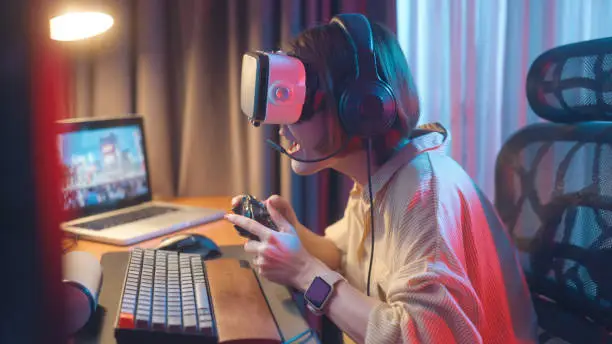Virtual reality gaming has been “the next big thing” for what feels like decades. From the failed experiments of the 1990s to today’s sophisticated headsets, VR has promised to revolutionize how we play games. But with significant price tags, space requirements, and a still-developing library of games, many gamers are asking the crucial question: Is VR gaming finally worth it in 2025?
The Current State of VR Gaming
Hardware Landscape
The VR hardware market has matured significantly, offering options for every budget and use case:
| Headset Category | Price Range | Notable Models | Key Features |
|---|---|---|---|
| Budget/Mobile | $200-$400 | Meta Quest 3S, Pico 4 | Standalone, no PC required, decent performance |
| Mid-Range | $500-$800 | Meta Quest 3, PSVR2 | Better displays, enhanced tracking, wider game selection |
| High-End | $1000-$2000 | Valve Index, HTC Vive Pro 2 | Premium displays, precise tracking, PC required |
| Ultra Premium | $2000+ | Varjo Aero, Pimax Crystal | Professional-grade visuals, enthusiast features |
Key Improvements Since Early VR:
• Resolution – Modern headsets offer 4K+ per eye, eliminating the “screen door effect”
• Wireless Freedom – Standalone and wireless PC streaming options remove cable constraints
• Inside-Out Tracking – No external sensors needed for most headsets
• Comfort – Lighter designs with better weight distribution for longer play sessions
• Field of View – Wider FOV approaching natural human vision (110-140 degrees)
• Refresh Rates – 90-120Hz standard, with some reaching 144Hz for smoother motion
The Game Library: Quality Over Quantity
VR gaming has evolved from tech demos to full-fledged experiences. The current library includes:
Must-Play VR Exclusives:
• Half-Life: Alyx – Valve’s masterpiece that proved VR could deliver AAA narratives
• Beat Saber – The rhythm game phenomenon that’s become VR’s killer app
• Asgard’s Wrath 2 – A 100+ hour RPG epic exclusive to Quest
• Gran Turismo 7 (PSVR2) – Full racing simulation transformed by VR immersion
• Boneworks/Bonelab – Physics-based gameplay only possible in VR
• The Walking Dead: Saints & Sinners – Survival horror that leverages VR’s tension
Popular VR-Enhanced Games:
• Microsoft Flight Simulator – Unparalleled immersion for aviation enthusiasts
• Skyrim VR – The full Elder Scrolls experience in virtual reality
• No Man’s Sky VR – Space exploration that feels genuinely otherworldly
• Resident Evil 4 VR – Classic reimagined with motion controls
• Star Wars: Squadrons – Dogfighting that fulfills childhood dreams
The Case FOR VR Gaming
Unique Experiences Impossible Elsewhere
VR offers gameplay mechanics and experiences that simply cannot be replicated on traditional screens:
- True 3D Spatial Awareness – Looking around corners, ducking behind cover naturally
- Intuitive Controls – Throwing, grabbing, and manipulating objects with your hands
- Physical Engagement – Games that double as exercise (FitXR, Supernatural)
- Presence and Immersion – The feeling of “being there” in game worlds
- Social VR – Meeting friends in virtual spaces that feel remarkably real
- Scale and Perspective – Experiencing true size of environments and creatures
Health and Fitness Benefits
| VR Fitness Game | Calories/Hour | Equivalent Activity | Fun Factor |
|---|---|---|---|
| Beat Saber (Expert) | 400-600 | Tennis | ★★★★★ |
| Thrill of the Fight | 600-800 | Boxing workout | ★★★★☆ |
| Pistol Whip | 300-500 | Dancing | ★★★★★ |
| FitXR | 400-600 | Aerobics class | ★★★★☆ |
| Synth Riders | 300-400 | Light jogging | ★★★★☆ |
The Case AGAINST VR Gaming
Persistent Challenges:
• Motion Sickness – Still affects 20-40% of users, especially in smooth locomotion games
• Setup Requirements – Need 6.5ft x 6.5ft minimum play space for room-scale
• Isolation – Can’t easily share the experience with others in the room
• Comfort Issues – Extended play can cause fatigue, eye strain, “VR face”
• Cost of Entry – Quality setup still requires $500-1500 investment
• Limited AAA Support – Many major publishers still treating VR as experimental
Technical Limitations:
- Battery Life – Standalone headsets typically last 2-3 hours per charge
- Graphics Compromise – Mobile chipsets can’t match PC/console visual fidelity
- Field of View – Still narrower than natural human vision
- Wireless Streaming Lag – PC VR streaming can introduce latency
- Lens Artifacts – God rays, chromatic aberration in some headsets
Cost Analysis: Is It Worth Your Money?
Initial Investment Breakdown:
| Setup Type | Minimum Cost | Recommended Cost | What You Get |
|---|---|---|---|
| Entry-Level VR | $300-400 | $500-600 | Quest 3S + accessories |
| Console VR | $550 | $750 | PSVR2 + PS5 (if needed) |
| PC VR | $1000 | $2000+ | Headset + gaming PC |
| Full Room Setup | $1500 | $3000+ | Premium headset + PC + accessories |
Hidden Costs to Consider:
• Accessories – Elite straps ($50-100), prescription lenses ($80), extra batteries ($30)
• Play Space – May need to rearrange furniture or dedicate a room
• Games – VR titles typically $20-60, limited sales compared to flat games
• Upgrades – PC users may need GPU upgrades for optimal performance
• Replacement Parts – Controllers, cables, facial interfaces wear over time
Who Should Buy VR in 2025?
VR Is Worth It If You:
- Love New Experiences – Crave unique gameplay impossible on traditional platforms
- Have Space – Can dedicate at least a 6×6 ft area for room-scale play
- Enjoy Active Gaming – Want games that get you moving and exercising
- Are Social Gamers – Interested in VR chat, social spaces, and multiplayer
- Have Specific Interests – Racing sims, flight sims, or rhythm games
- Can Handle the Investment – Comfortable spending $500+ on gaming hardware
Maybe Wait If You:
- Get Motion Sick Easily – VR might be uncomfortable without gradual acclimation
- Have Limited Space – Less than 6×6 ft severely limits game options
- Prefer Story-Driven Games – VR library still limited in narrative experiences
- Game Casually – Setup/teardown process not ideal for quick sessions
- Have Budget Constraints – Better to wait for prices to drop further
Wear Thick Glasses – May need prescription lens inserts (extra cost)
The Future Outlook
Coming in 2025-2027:
- Apple Vision Pro Gaming – High-end mixed reality entering gaming space
- Meta Quest 4 – Expected significant leap in mobile VR performance
- Wireless PCVR Standard – Better protocols for lag-free streaming
- Eye Tracking Standard – Foveated rendering for better performance
- Haptic Suits – Full-body feedback for deeper immersion
- Cloud VR Gaming – Streaming high-end VR without local hardware
Industry Trends:
- Major Publishers Investing – Ubisoft, EA, and others committing to VR
- Cross-Platform Play – More games supporting VR and flat screen players together
- AI Integration – Smarter NPCs and procedural content in VR
- Mixed Reality Focus – Blending virtual and real environments
- Standardization – OpenXR making development easier across platforms
The Verdict: Is VR Gaming Worth It Yet?
The answer depends entirely on what you’re looking for from gaming. VR in 2025 is no longer a gimmick or proof of concept—it’s a legitimate gaming platform with unique strengths and persistent weaknesses.
VR Gaming IS Worth It For:
- Enthusiasts seeking cutting-edge gaming experiences
- Fitness-minded gamers wanting active entertainment
- Simulation fans who crave maximum immersion
- Early adopters comfortable with emerging technology
- Social gamers interested in new ways to connect
VR Gaming ISN’T Worth It Yet For:
- Casual players who value convenience over immersion
- Budget-conscious gamers with limited disposable income
- Traditional gamers satisfied with current gaming options
- Those with space/physical limitations
- Gamers waiting for the “perfect” headset
Final Thoughts
Virtual reality gaming has reached a tipping point where it’s genuinely worth considering for many gamers, but it’s not yet essential for everyone. The technology has matured significantly, offering experiences that justify the investment for those seeking something beyond traditional gaming.
The best approach might be to start small—try VR at a friend’s house or gaming café, or invest in an affordable Quest 3S to test the waters. If you find yourself drawn to the unique experiences VR offers, you can always upgrade to more premium hardware later.
Ultimately, VR gaming in 2025 is worth it if you’re looking for new types of gaming experiences and can accommodate the current limitations. For everyone else, waiting another generation or two might be the smarter play. The future of VR gaming is bright, and whether you jump in now or later, incredible experiences await.














